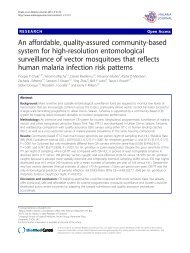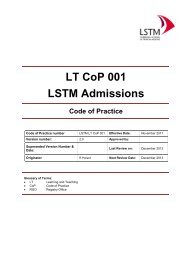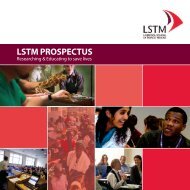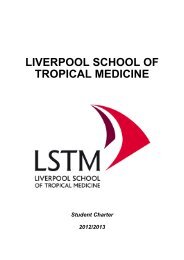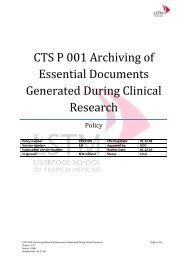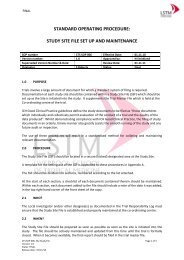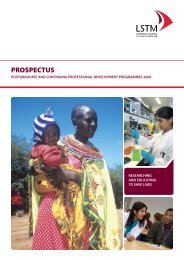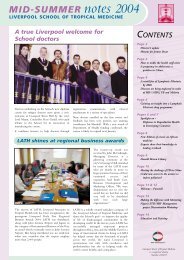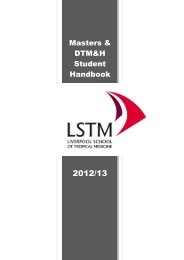Gender influences on child survival, health and nutrition: a ... - Unicef
Gender influences on child survival, health and nutrition: a ... - Unicef
Gender influences on child survival, health and nutrition: a ... - Unicef
You also want an ePaper? Increase the reach of your titles
YUMPU automatically turns print PDFs into web optimized ePapers that Google loves.
<str<strong>on</strong>g>Gender</str<strong>on</strong>g> Influences On Child Survival, Health And Nutriti<strong>on</strong>: A Narrative Review<br />
et al. 2006). The authors argue that mothers engaged in paid work as well as poor mothers who are not<br />
in paid work nevertheless face time c<strong>on</strong>straints due to their reproductive resp<strong>on</strong>sibilities <strong>and</strong> lack of<br />
appropriate substitute caregivers. The use of peer care, or younger family members, by both working<br />
<strong>and</strong> n<strong>on</strong>-working mothers was also associated with a 7-fold <strong>and</strong> 4-fold higher risk of <strong>child</strong>ren being<br />
underweight <strong>and</strong> stunted, respectively (ibid.) 14 .<br />
A study c<strong>on</strong>ducted in Haiti, based <strong>on</strong> interviews with 106 women across three villages, found that a<br />
greater proporti<strong>on</strong> (38%) of those households with a malnourished <strong>child</strong> (based <strong>on</strong> weight for age<br />
measurements) used an alternate, male care giver when the mother was away from the household<br />
(Devin & Ericks<strong>on</strong> 1996). These male care givers were typically used as a “last resort” where alternative<br />
female carers (such as gr<strong>and</strong>mothers) were not available. Follow-up interviews were carried out with<br />
women <strong>and</strong> men in households where wives had reported that men were left to care for <strong>child</strong>ren <strong>and</strong><br />
researchers found that although men fulfilled many of the same duties as the women (preparing meals<br />
<strong>and</strong> feeding <strong>child</strong>ren) they also had other resp<strong>on</strong>sibilities (such as moving animals between grazing<br />
areas) which required them to leave the <strong>child</strong>ren at times during the day. As these were the households<br />
in which alternative older female caregivers were not available, <strong>child</strong> care was then passed to siblings,<br />
often very young themselves <strong>and</strong> ill-equipped for the resp<strong>on</strong>sibility of caring for infants.<br />
This secti<strong>on</strong> has highlighted that:<br />
‣ Both working <strong>and</strong> n<strong>on</strong>-working mothers would benefit from access to appropriate <strong>child</strong><br />
care support.<br />
‣ Under-nutriti<strong>on</strong> is linked in some cases to the lack of appropriate alternative carers<br />
within families due to precarious socio-ec<strong>on</strong>omic circumstances <strong>and</strong> the pressure <strong>on</strong><br />
parents <strong>and</strong> other members of the household to secure livelihoods.<br />
1.2.4 PATERNAL ROLES AND CHILD HEALTH<br />
While men may become involved in <strong>child</strong> care in situati<strong>on</strong>s where there are no available female carers<br />
(as the Haiti study menti<strong>on</strong>ed above dem<strong>on</strong>strates) generally the gender divisi<strong>on</strong> of labour between<br />
men <strong>and</strong> women dictates that women provide the majority of the <strong>child</strong> care <strong>and</strong> men fulfill some sort of<br />
income-generating role. In recent years however there has been a growing interest in the role of men in<br />
relati<strong>on</strong> to <strong>child</strong> care <strong>and</strong> although much of this research has focused <strong>on</strong> post-industrial c<strong>on</strong>texts, some<br />
studies have specifically explored father’s roles in low <strong>and</strong> middle income c<strong>on</strong>texts (Barker, Lyra &<br />
Medrado 2003; Hossain et al. 2005; Lyra 2003; Roopnarine et al. 1995).<br />
REVIEW OF STUDIES<br />
14 As discussed in secti<strong>on</strong> 1.1.4 peers can both help <strong>and</strong> hinder <strong>child</strong> <strong>health</strong> <strong>and</strong> nutriti<strong>on</strong> outcomes depending <strong>on</strong><br />
the compositi<strong>on</strong> <strong>and</strong> structure of the household. This finding lends strength to the argument that alternative care<br />
for <strong>child</strong>ren is sensitive to c<strong>on</strong>text which should be taken into account when exploring opportunities for addressing<br />
<strong>child</strong> care provisi<strong>on</strong>.<br />
38



